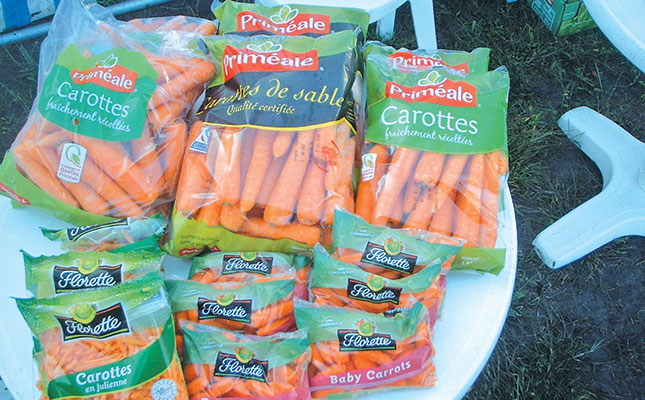
Photo: Bill Kerr
Presentation goes all the way back to the land, where the time of harvesting influences the shape, and mainly the tip of the carrot.
Our market prefers a cylindrical root with a blunt tip, which will usually only round off at full maturity. (Some varieties will round off at a younger stage than others.)
Maturity of carrots can be determined by lifting, removing the tops and leaving the root on a shelf for a day. Immature carrots will become flaccid and easy to bend compared with mature roots.
The leaves of mature carrots will also start yellowing from ground level.
Only for certain markets
By contrast, the bunched market will accept a more pointed carrot as this is perceived to be a younger carrot picked on the immature side and sweet, juicy and tender.
To some extent, this perception may be valid, but younger carrots wilt faster and the large leaf area also draws out moisture limiting the shelf life.
Bunched carrots are only good for certain markets, where the time from harvesting to purchasing is rather short and you can keep the bunches moist and cool.
If you’re aiming for the bunched market, make sure that the attachment of the leaves to the root is strong enough to stay intact during handling.
Many varieties have been bred to break easily so that they are quicker and easier to remove for the pre-pack market.
However, with mechanical lifting fast becoming the norm, breeders have to ensure that the attachment will withstand the process without breaking.
Another aspect of bunching is to ensure that the leaves are a rich, green colour and healthy. It is the contrast of bright, green tops and dark orange roots that appeals to customers.
Packed carrots
Pre-packs and bags are usually clear plastic, often with orange stripes printed on the packaging. This makes the carrots look darker than they actually are.
Where carrots are packed in outlets under fluorescent lighting, the type of lighting can have an influence on the colour.
I remember one agent on the Johannesburg market years ago who used different lighting to that of his competitors.
This made his carrots look a darker shade of orange; consequently, he sold more than the other agents.
I would take some carrots from another agent to this agent and see how the colour changed before my eyes.
Grading and uniformity of size and shape all play a big role on our markets.Even if they’re bagged, you will get a better price when the carrots are all aligned and not just tipped
into the bag.
The bag may weigh the same and the quality may be identical, but buyers are immediately attracted to a product that looks more presentable.
This is usually even more important than quality. On a trip to France, I was amazed to see that all their pre-packs were bundled loosely into the packaging with no alignment whatsoever.
I reckoned that because their labour was expensive, farmers dispensed with this extra cost and ‘loose bundles’ became the norm.
Certainly, our alignment practices were introduced when labour used to be cheap and we’re stuck with the system now that labour is expensive.
Most carrot producers are now large and offer their product year-round. Shelf-life and quality are prime considerations, as these producers will have developed a regular clientele who trust the ‘brand’.
A new entrant to the market needs to take this into consideration.
If the quality is not always up to standard, rather use a second ‘cheaper’ label so as to build up trust in the premium product and gradually increase the demand and price received.
Hydro-cooled produce
Other factors to consider are hydrocooling and taste. Hydro-cooling of the roots in the pack-shed and maintaining the cold chain into the store will enhance the shelf life and quality.
It’s a good idea to state on the package that the product has been hydro-cooled, as this will give the customer more confidence in it.
Taste is very much dependent on variety, but is also affected by fertility, growing practices and season.
Needless to say, a better taste will draw more clients to your label.












